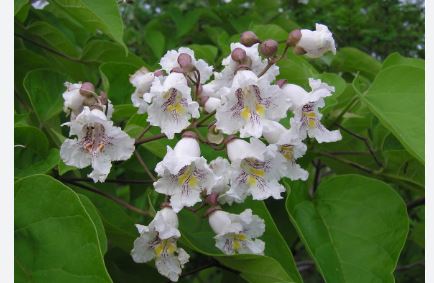
Catalpa (Catalpa spp.) is a genus of flowering plants in the family Bignoniaceae, native to warm temperate and subtropical regions of North America, the Caribbean, and East Asia.
Also known as southern catalpa, hardy catalpa, western catalpa, northern catalpa, catawba, cigar tree and caterpillar tree, it is native to a wide-ranging area including North America, the Caribbean and East Asia. It’s been cultivated throughout the US since the early 1800s.
Catalpa trees have large, heart-shaped leaves that can be up to 12 inches long. They are arranged in a whorled or opposite pattern on the branches. In late spring to early summer, Catalpa trees produce large, showy, bell-shaped flowers. These flowers are often white with yellow stripes and purple or brown spots inside, grouped in large clusters or panicles.
After flowering, Catalpas develop long, slender seed pods often referred to as “cigar” or “bean” pods due to their shape. These pods can grow from 8 to 20 inches long, containing numerous flat seeds with winged ends.The bark is somewhat rough, with a texture that can become more ridged or scaly as the tree ages.
Catalpa trees can grow quite large, reaching 40-60 feet in height with a spread almost as wide, though some species might remain smaller. Under optimal conditions, they can grow 1 to 2 feet per year or even more when young. In some cases, particularly during their first few years, growth might exceed this rate if the conditions are ideal (rich soil, adequate moisture, and full sun).
Catalpa trees reach maturity relatively quickly for a tree, often beginning to flower and produce seed pods within 6 to 12 years after planting, depending on how they are grown (from seed or grafted saplings). On average, a Catalpa tree might live for 50 to 150 years.
Proper care, including watering, pruning, and protection from mechanical damage, can extend their life. Urban conditions, like pollution or restricted root space, might shorten their lifespan. While Catalpas are relatively resistant to many diseases, they can be affected by issues like verticillium wilt, and pests like the Catalpa sphinx moth larvae can defoliate trees, potentially impacting health if infestations are severe or recurrent.
Though its tendency to spring up in odd places and grow rather quickly has earned it a reputation of being a bit of a “weed tree,” plenty of folks love having this large graceful shade trees on their properties. They became popular at the turn of the century in the Northeast US and one often sees streets or cul-de-sacs named some variation “Catalpa Terrace” or “Catalpa Circle.”

Species
There are two main species of catalpa tree grown in North America, the northern catalpa and southern catalpa, both of which are fairly similar. The Chinese catalpa is a somewhat different species with yellow flowers, also known as yellow catalpa. All three are commonly planted outside their native areas as ornamental landscape trees.
- Northern Catalpa (Catalpa speciosa): Native to a relatively small area in the U.S. Midwest but widely planted elsewhere for its hardiness and rapid growth. It has larger flowers than the Southern Catalpa.
- Southern Catalpa (Catalpa bignonioides): More widespread in the southeastern United States. It’s somewhat smaller than the Northern Catalpa and has been used more in ornamental plantings.
- Chinese Catalpa (Catalpa ovata): Not as common in the Americas but planted for ornamental purposes in other parts of the world, known for its smaller size and yellow flowers.
- Haitian catalpa (Catalpa longissima)– Catalpa longissima can grow up to 25 meters tall with an open crown.
Cultivation and Uses
- Climate: Catalpas are generally hardy in USDA zones 4-8, though this can vary by species.
- Soil: They prefer moist, deep, well-drained soil but are adaptable to various soil conditions, including alkaline soils.
- Sunlight: Full sun to partial shade; they flower best in full sun.
- Water: While they can tolerate some drought once established, regular watering will promote better growth and flowering.
- Ornamental Use: Due to their large leaves, attractive flowers, and unique seed pods, Catalpas are often planted as specimen trees in parks, large gardens, or along streets.
- Pest: The Catalpa tree is notably the primary host for the Catalpa sphinx moth caterpillars, which some people raise for fishing bait because they are large and fleshy.